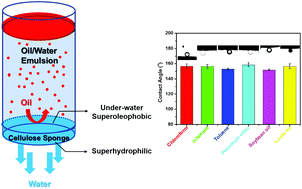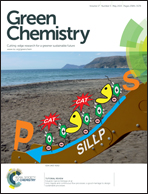A cellulose sponge with robust superhydrophilicity and under-water superoleophobicity for highly effective oil/water separation†
Abstract
We fabricate a cellulose sponge with stable superoleophobicity (θoil > 150°) under water and superhydrophilic wettability (θwater ≈ 0°) under oil without any further chemical modification for oil–water emulsion separation. The cellulose sponge shows superoleophobicity to various oils under water and possesses stable superoleophobicity in corrosive liquids like strong acid, alkali and salt solution. The sponge is made from the dissolution and regeneration of cellulose powder which is green, low cost, simple and easy to scale up. The natural hydrophilicity of the cellulose ensures its excellent under-water superoleophobicity and antifouling properties. The double layer construction of different pore sizes, which contains a top-layer with a pore size lower than 1 μm and a sub-layer with a pore size larger than 3 μm, ensures that the oil phase is resisted and the water phase easily and quickly permeates the sponge. Our cellulose sponge can separate oil–water mixtures, with >99.94% separation efficiency, solely using gravity and has excellent antifouling properties.

- This article is part of the themed collection: 2015 most accessed Green Chemistry articles

 Please wait while we load your content...
Please wait while we load your content...